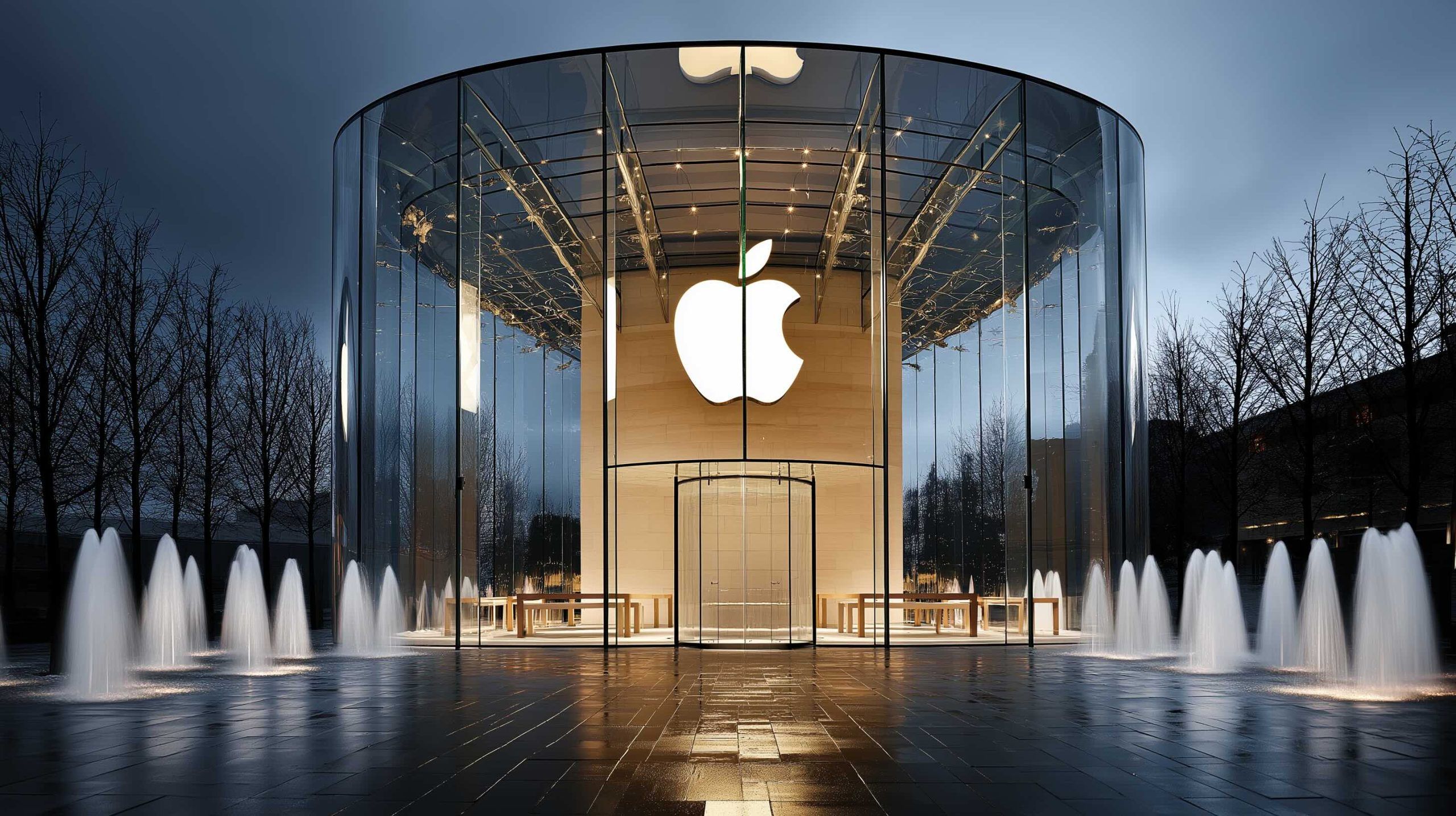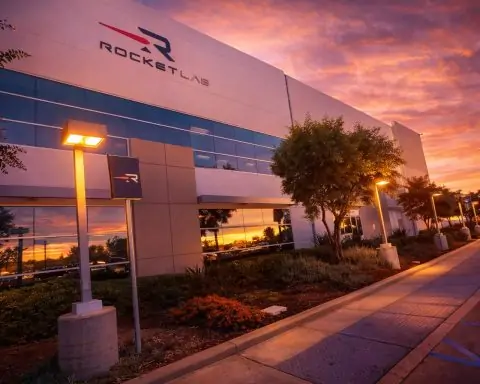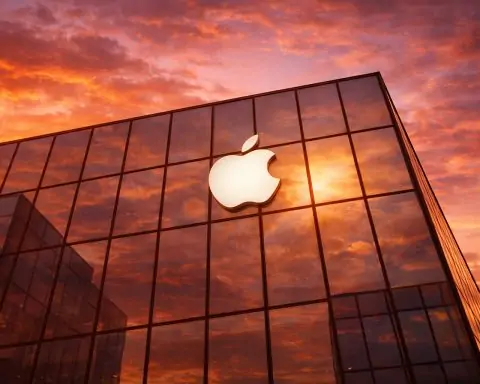- Valuation (Sept 30, 2025): AAPL closed around $254, giving it a market cap of roughly $3.8 trillion [1]. Its trailing P/E is high (~39×) with a modest dividend yield (~0.4%) [2].
- 2025 Performance: Apple’s stock has been roughly flat YTD (≈+2%) as of late September, underperforming peer tech names (Nvidia +35%, Microsoft +23%, Alphabet +29%, Amazon +1%) [3]. The June-quarter results beat forecasts (Q3 sales $94.0 B, +9.6% YoY; EPS $1.57 vs $1.43 est.) [4], powered by strong iPhone, Mac, and services growth. Apple guided for mid- to high-single-digit revenue growth in fiscal Q4 FY2025 [5].
- Key News (Sep 30–Oct 1, 2025): On Sept 30 Apple shares traded slightly higher amid high volume [6]. Investor focus is on Apple’s accelerated AI integration roadmap and looming regulatory changes – notably the EU’s Digital Markets Act forcing iPhones to allow third-party app stores by 2026 [7]. Reports also surfaced that Apple is developing an internal AI chatbot (“Veritas”) to revamp Siri, with a new on-device Siri anticipated in 2026 [8].
- Analyst Views: Experts remain broadly positive. The consensus rating is “Buy,” but the average 12-month target (~$243) is slightly below current levels [9]. Top bulls see much higher. Wedbush’s Daniel Ives raised his 2026 target to $310 on strong early iPhone 17 demand [10]. Bernstein, Evercore, and BofA have 12-month targets near $290 [11] [12]. Morgan Stanley and Wedbush highlight Apple’s huge upgrade base and AI potential [13] [14] (see below).
- Macro/Industry Factors: Apple is navigating geopolitical and economic headwinds. Tariffs on Chinese-made products have encouraged some pull-forward buying (Apple saw record seasonal upgrades of iPhones/Macs ahead of tariff hikes) [15]. Supply chains are shifting – Apple is moving more production to India and Vietnam to sidestep tariffs [16]. Meanwhile, higher global interest rates and inflation could damp consumer upgrades, and Apple faces tough competition from Samsung in smartphones and from AI-centric rivals (Google, Microsoft, Nvidia) in technology. Finally, regulatory pressure (EU antitrust, Epic Games litigation, DOJ/Google search rulings) could erode Apple’s services revenue over time [17] [18].
Apple’s 2025 Performance and Q4 Outlook
Apple’s stock has had a choppy year. After a selloff in early 2025, the shares rebounded following strong Q3 results in July. Fiscal Q3 (ending June 28) revenue was $94.0 billion (up ~10% YoY) with EPS $1.57, topping consensus [19]. All major segments grew: iPhone sales jumped 13.5% (to $44.6 B) [20], Mac sales beat expectations, and services hit a new record ($27.4 B, +13% YoY [21]). Growth was especially strong in emerging markets. Apple’s guidance for fiscal Q4 was optimistic: CFO Luca Maestri said revenue should rise in the “mid- to high single digits” year-over-year [22], implying growth above the low-single-digit consensus. This outlook reflects expected ongoing momentum in iPhone and Mac (with new products) as well as continued expansion of services and AI-related investment.
As of late September, Apple’s stock price (~$254) and valuation reflect that mixed picture: shares are roughly flat for 2025 (about +2% YTD) [23]. That underperforms the broader tech sector; for comparison, peer stocks are up strongly (e.g. NVDA +35%, MSFT +23%) [24]. Analysts note Apple now trades above its 200-day and 50-day averages, a bullish technical setup [25]. But with a steep P/E (~38× trailing) and mixed near-term catalysts, many say upside is modest. The average price target is actually about $243 [26] (slightly below today’s price). Still, some see big opportunities in Apple’s ecosystem growth and product pipeline.
Recent Events (Late Sep/Early Oct 2025)
In late September 2025 the most important news around Apple had less to do with immediate product announcements and more with tech trends and policy. On Sept. 30, U.S. markets noted Apple shares edging up amidst heavy volume [27]. Commentators pointed to two big themes: a push into AI features and looming regulation. The European Union’s Digital Markets Act (DMA) was finalized to force Apple to allow third-party app stores on iPhones by 2026 [28]. This will alter Apple’s App Store economics and require technical changes. At the same time, rumors (citing Bloomberg) suggested Apple is testing a new AI chatbot internally (“Veritas”) as the foundation for a revamped Siri [29]. In short, investors were parsing how Apple’s software strategy and regulatory obstacles are shaping its near-term outlook.
There have been no new Apple hardware events precisely on Sept 30/Oct 1. (The annual iPhone 17 launch was in early September.) However, industry watchers note Apple is likely preparing a final wave of 2025 products. Reports indicate Apple is mass-producing the next-generation chipsets (M5 series) for an expected late-2025/early-2026 rollout [30]. An October event might deliver updated iPad Pro (with M5 chips), new MacBook Pros, a Vision Pro refresh, and smart-home devices — though some sources say major MacBook Pro updates may slip to early 2026 [31]. In summary, the very latest news is more about Apple’s future roadmap (AI, chips, new devices) and regulatory changes than any single new product announced on Oct 1.
Products, Services and Innovation Pipeline
Apple continues to diversify its product and services mix. The flagship iPhone remains the cash cow: the new iPhone 17 lineup (launched Sept 2025) introduced enhanced displays, cameras, and higher base storage. Early reports are positive: Wedbush and others note strong initial demand for iPhone 17, especially the new iPhone Air, which is lower-cost yet “more awe-dropping” than expected [32] [33]. Wedbush sees about 325 million active iPhones over 4 years old still in use worldwide, signaling a huge upgrade opportunity [34] [35]. (In fact, Tim Cook said Apple’s total iPhone user base hit a record high this quarter [36].) A slight $100 price bump on the Pro model (largely due to tariffs and supply costs) was offset by higher trade-in values and discounts on legacy models [37], so the company believes buyers won’t balk at modestly higher prices.
Mac and iPad: Apple’s M-series silicon refresh continues. The latest Macs use the M4 chip (released late 2024). Industry leaks suggest even faster M5, M5 Pro/Max chips are entering production [38]. We expect new MacBook Pro, iMac and Mac mini models running M5 sometime late 2025 or early 2026. Apple’s high-end iPad Pro is also due for an update with M5 chips and improved cameras [39] [40].
Wearables/Accessories: The Apple Watch and AirPods remain strong contributors, though Apple hasn’t signaled any major overhauls. One development: U.S. watches have re-enabled blood-oxygen readings (a government change) [41], which could slightly boost Apple Watch sales. Rumors also swirl of new HomePod minis, AirTags (with longer range), and Apple TV hardware (with A17 Pro chips and FaceTime cameras) later this year [42].
Services and AI: Apple’s services segment (App Store, Music, iCloud, etc.) keeps growing. Q3 services revenue hit $27.4 B (a record, +13% YoY) [43]. Apple is aggressively investing in AI across its ecosystem: the on-device “Apple Intelligence” features in iOS 18.x (like Live Text translation, Siri improvements, image tools) are expanding globally [44]. Executives have emphasized AI as a top priority: CFO Maestri said Apple is “increasing our investment significantly in AI” (building new data centers and cloud capacity) [45]. CEO Cook echoed this, noting the company is “significantly growing” its AI investments and working on a more capable Siri [46]. An internal OS project codenamed “Charismatic” (per MacRumors) and rumored partnerships with AI firms suggest major software upgrades (AI-powered Siri, new VisionOS updates) are in the pipeline [47] [48].
Macro and Industry Trends
Apple’s results are influenced by broad trends. Global economy/interest rates: Moderating economic growth and higher interest rates could temper consumer spending on premium phones. Inflation and central bank policies affect discretionary buying. Supply chain and production: Apple has systematically diversified production away from China. Now many iPhones are assembled in India, and Macs/AirPods in Vietnam [49]. This reduces U.S. tariff risk (Apple estimates a ~$1.1 B tariff hit in one quarter [50]) and aligns with political pressures (Apple has promised $600 B U.S. investments through 2029). Competition: Apple faces stiff rivalry. In smartphones, Samsung is a fierce competitor, especially in Asia. In PCs/tablets, competition from Microsoft/Intel ecosystem is growing. In wearables and services, Amazon, Google, and Microsoft all offer alternative ecosystems. Importantly, AI race: Nvidia, Microsoft and Google are ahead in cloud AI infrastructure (Nvidia’s market cap now surpasses Apple’s [51]). Apple’s approach—adding AI “features” to devices—lags pure AI players. This perception has weighed on the stock (investors note Apple’s slower Siri rollout [52]). Regulation: Apple is under scrutiny globally. In addition to the EU’s DMA, legal rulings (e.g. Australia, Epic Games) are forcing Apple to allow more app store flexibility [53]. U.S. antitrust pressure looms, though Apple won some recent suits. These regulatory trends could cap Apple’s software margins and fees.
Despite these headwinds, many trends favor Apple. The large installed base (≈1.5 B active devices [54]) means recurring upgrade cycles and services revenue. Apple’s growing ecosystem (payments, cloud services, original content) offers new growth levers beyond hardware. For now, analysts point out that Apple has stayed profitable (Q3 gross margin ~46.5%, above estimates) even as it invests in R&D and AI [55]. But earnings will depend on sustaining demand and expanding services in a challenging environment.
Analyst Sentiment & Long-Term Forecasts
Wall Street’s view on Apple is mixed-to-cautious. On one hand, analysts like Morgan Stanley highlight Apple’s strengths: a record iPhone user base, long replacement cycles, and early AI enhancements. Morgan Stanley maintains an Overweight rating (12M target $240) and argues “Apple can accelerate iPhone growth starting in FY26” thanks to pent-up demand and new AI features [56]. Morgan analysts also emphasize Apple’s “long runway” to boost revenue from AI, payments, health, etc. [57]. Wedbush (Ives) is also bullish: Outperform rating, $270 target, citing a massive upgrade opportunity (some 325 million iPhones >4 yrs old) and the coming “Apple Intelligence” upgrades [58] [59]. BofA and Bernstein similarly see room for EPS growth (BofA just upped its FY2026 EPS model from $8.37 to $8.40 and price target to $270) [60].
On the other hand, many analysts are wary. The average 12-month price target on AAPL is only $243 (≈–4% downside) [61]. Key concerns: smartphone market saturation, margin pressure, and whether Apple can meaningfully compete in AI. For example, Jefferies has a “Hold” with a $206 target, and DA Davidson’s Gil Luria recently downgraded Apple from Strong Buy to Hold (target $250) [62]. Some model-driven forecasts are even more pessimistic: a TipRanks survey showed only ~55% of analysts now recommend buying Apple [63].
Looking further out (2026–2030), forecasts vary widely. A moderate scenario (implied by consensus) is revenue growth tapering to the high single-digits and EPS around $8–9 by 2027 [64]. But bulls paint a rosier picture. The research outlet 24/7 Wall St. projects Apple stock could reach ~$357 by 2030 (+49%) if “Apple Intelligence” fully integrates across devices [65]. Even today, analysts are projecting Apple EPS of about $7.5 in FY2025 and $8.1–8.4 in FY2026 [66] [67]. Much will depend on Apple’s ability to innovate (foldable iPhones, AR/VR, new services) and fend off competitors.
Below is a snapshot comparison of Apple vs. big-tech peers (data as of late Sept 2025) [68] [69]:
| Company (Ticker) | Market Cap | YTD 2025 Total Return |
|---|---|---|
| Nvidia (NVDA) | $4.40T [70] | +35.5% [71] |
| Microsoft (MSFT) | $3.82T [72] | +22.8% [73] |
| Apple (AAPL) | $3.77T [74] | +2.0% [75] |
| Alphabet (GOOGL) | $2.95T [76] | +29.3% [77] |
| Amazon (AMZN) | $2.37T [78] | +1.3% [79] |
(Sources: FinanceCharts [80] [81].)
Expert Commentary (Quotes)
- Wedbush: “The Apple Intelligence rollout and record iPhone 17 demand have us raising our 12-month target to $310” [82]. Analyst Dan Ives notes Apple’s massive upgrade pipeline (hundreds of millions of old iPhones) as a bullish catalyst [83].
- Morgan Stanley: Maintains Overweight on AAPL (12M $240). “Apple’s largest base of pent-up iPhone demand, new AI features slowly rolling out, and renewed device innovation should accelerate iPhone growth starting FY26,” the team says [84]. They also call Apple’s long-term AI and services investments “key arguments for sustained growth” [85].
- BofA Securities: Recently Buy-rated, price objective $270. Analyst Wamsi Mohan points out Apple raised iPhone prices slightly (to offset tariffs) but improved trade-in/deals may boost upgrades. He forecasts CY2026 EPS ~$8.40, reflecting continued margin strength [86].
- Apple Management: CEO Tim Cook emphasizes AI features. In recent comments he stressed that Apple is “significantly growing” its AI investments and has made “good progress” on a personalized Siri [87]. CFO Luca Maestri similarly said a “significant portion” of Apple’s higher CapEx is going into AI infrastructure [88]. These quotes underline Apple’s pivot to AI-driven R&D.
Risks and Opportunities
Opportunities: Apple’s biggest strength is its ecosystem and brand loyalty. With over 1.5 billion active devices worldwide [89], Apple has enormous cross-selling and upgrade potential. The company now boasts over $408 B in trailing revenues [90] (behind roughly $100 B in profit), showing high productivity. Continued service innovations (e.g. bundled offerings, new AI features in apps) and new hardware (AR/VR, foldables?) could unlock new growth. For example, CEO Cook noted that record numbers of customers upgraded iPhones, Macs and Watches this quarter [91], and analysts see a “super-cycle” ahead as Apple rolls out richer features (like on-device AI) [92]. Any success in new markets (smartcars, health tech, streaming) would be major tailwinds.
Risks: Key risks include intensifying competition and higher expectations. Apple’s premium smartphone market is maturing; analysts question whether Apple can keep commanding high prices [93] [94]. Competition from lower-cost Android manufacturers (Samsung, Huawei/Xiaomi in China) could erode market share. If Apple’s AI features prove less impressive than rivals’, investors may de-rate the stock: Apple’s shares fell ~17% in 2025 amid concerns over tariffs and “slow progress integrating AI” [95]. Regulatory challenges pose additional risk. The EU’s forced app-store changes and other antitrust moves could reduce App Store fees and services revenue [96] [97]. Geopolitical tensions (China-U.S. trade policy) add uncertainty to Apple’s supply chain. Finally, high current valuation leaves less margin for error; disappointments in sales or profitability would likely trigger steeper stock declines.
In summary, Apple remains a powerhouse with a vast loyal customer base and solid fundamentals, but its growth is facing new hurdles. Investors should weigh the company’s long-term innovation pipeline (AI, services, new products) against near-term pressures (regulation, competition, global economy). As one strategist put it, Apple has the pieces for a “super cycle” ahead, but only if it can rapidly execute on AI and keep its premium appeal [98] [99]. Citations above detail the latest analyst viewpoints, financial metrics, and news events shaping Apple’s outlook in 2025 and beyond.
Sources: Official Apple filings and press releases; major financial news (Reuters, AppleInsider, Quartz, etc.); analyst reports and industry analyses [100] [101] [102] [103]. Each fact is drawn from these cited sources.
References
1. www.financecharts.com, 2. www.financecharts.com, 3. www.financecharts.com, 4. www.reuters.com, 5. www.nasdaq.com, 6. www.ainvest.com, 7. www.ainvest.com, 8. www.insidermonkey.com, 9. stockanalysis.com, 10. appleinsider.com, 11. stockanalysis.com, 12. stockanalysis.com, 13. qz.com, 14. qz.com, 15. www.reuters.com, 16. www.reuters.com, 17. www.investing.com, 18. www.ainvest.com, 19. www.reuters.com, 20. www.reuters.com, 21. www.nasdaq.com, 22. www.nasdaq.com, 23. www.financecharts.com, 24. www.financecharts.com, 25. www.nasdaq.com, 26. stockanalysis.com, 27. www.ainvest.com, 28. www.ainvest.com, 29. www.insidermonkey.com, 30. www.macrumors.com, 31. www.macrumors.com, 32. appleinsider.com, 33. qz.com, 34. appleinsider.com, 35. qz.com, 36. www.reuters.com, 37. qz.com, 38. www.macrumors.com, 39. www.macrumors.com, 40. qz.com, 41. www.investing.com, 42. www.macrumors.com, 43. www.nasdaq.com, 44. www.nasdaq.com, 45. www.nasdaq.com, 46. www.reuters.com, 47. qz.com, 48. www.macrumors.com, 49. www.reuters.com, 50. www.reuters.com, 51. www.alpha-sense.com, 52. www.reuters.com, 53. www.investing.com, 54. appleinsider.com, 55. www.reuters.com, 56. qz.com, 57. qz.com, 58. appleinsider.com, 59. qz.com, 60. qz.com, 61. stockanalysis.com, 62. stockanalysis.com, 63. qz.com, 64. stockanalysis.com, 65. 247wallst.com, 66. stockanalysis.com, 67. qz.com, 68. www.financecharts.com, 69. www.financecharts.com, 70. www.financecharts.com, 71. www.financecharts.com, 72. www.financecharts.com, 73. www.financecharts.com, 74. www.financecharts.com, 75. www.financecharts.com, 76. www.financecharts.com, 77. www.financecharts.com, 78. www.financecharts.com, 79. www.financecharts.com, 80. www.financecharts.com, 81. www.financecharts.com, 82. appleinsider.com, 83. appleinsider.com, 84. qz.com, 85. qz.com, 86. qz.com, 87. www.reuters.com, 88. www.nasdaq.com, 89. appleinsider.com, 90. www.financecharts.com, 91. www.reuters.com, 92. qz.com, 93. www.investing.com, 94. qz.com, 95. www.reuters.com, 96. www.ainvest.com, 97. www.investing.com, 98. qz.com, 99. www.reuters.com, 100. www.reuters.com, 101. appleinsider.com, 102. www.nasdaq.com, 103. qz.com










